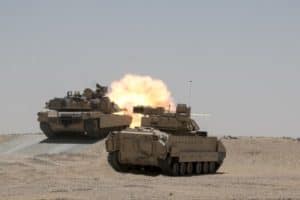This page contains affiliate links. This means if you a follow a link and make a purchase, at no additional cost to you, Humanitarian Careers will receive a commission. Thank you for supporting the site.
The United Nations is the most powerful international organisation in the world. It was established in 1945 with the aim of maintaining global peace, enhancing international security and improving relations between countries. However, what can the UN actually do to achieve these aims? When can the UN intervene? And, if it had to, could the UN actually invade a country?
The United Nations cannot invade a country. The UN does not have a standing army of its own and does not have the power to order the invasion of a sovereign state. The UN can approve the use of military force by member states, but it only does this in cases of self-defence or as humanitarian interventions.
Although the UN cannot itself invade a nation state, the United Nations does have protocols that allow it to use military force. The most famous way the UN uses armed forces are as UN peacekeepers. These are the military deployment of soldiers by member states under the authorisation of the UN to build and maintain peace. However, peacekeepers cannot be used to invade a country.
Outside of UN peacekeeping missions, the United Nations can authorise the use of military force by a member state, just not as an attack on another country. UN authorised military actions are only in cases of aggressions by another country or as a humanitarian intervention. No UN authorised use of military force by a member state has been an actual invasion of another country.
Now we know the United Nations cannot attack a country, let’s go over the main ways the UN can use military force…
UN Peacekeeping
United Nations peacekeeping is the deployment of military forces authorised and under operational control the UN. The aim of the UN peacekeeping is to ‘to help countries torn by conflict to create the conditions for lasting peace’.
UN peacekeeping missions are not invasions but the use of military actors to maintain peace and help countries build and retain security.
There are several ways that United Nations peacekeeping operations are different to an invasion of country. Firstly, UN peacekeeping missions are almost always undertaken with the authorisation and approval of the country’s government. This is different to an attack on a nation because it provides a national and international legitimacy to UN peacekeeping.
Another way that UN peacekeeping is not an invasion of a sovereign state is that they are approved by UN Security Council resolutions. United Nations peacekeeping operations are given a mandate by the security council to conduct specific operations to assist in peace building and prevent a return to armed violence. When one country attacks another, this is almost always in violation of the UN.
United Nations peacekeeping operations are under a strict mandate. The UN has never given a mandate for peacekeepers to invade a country. Some examples of mandates peacekeeping missions undertake include:
- Deployment to stop an outbreak of armed violence
- To prevent a conflict spreading across national borders
- Provide stabilisation to a conflict zone after a ceasefire
- Assist in the implementation of peace agreements
As you can see, UN peacekeeping mandates do not cover the invasion of another country, even on humanitarian grounds. Peacekeepers are deployed by the UN to assist countries in building peace, to contain conflicts or provide stabilisation in an area that has been recently affected by armed violence.
UN peacekeepers often come in after a peace agreement has been made and not as an attack on a country.
UN Authorised Military Actions: An Overview
The United Nations only approves the use of military action by member states very rarely. In fact, article 51 on the UN charter states:
‘’Nothing in the present Charter shall impair the inherent right of individual or collective self-defence if an armed attack occurs against a Member of the United Nations, until the Security Council has taken measures necessary to maintain international peace and security.’’
United Nations Charter, Article 51
This means that UN member states should only use their armed forces if attacked by another country or with the approval of the United Nations Security Council. This doesn’t happen a lot. In fact, the United Nations has only a few times approved military action by member states. Some of these occasions include:
- The Korean War, 1950 – 1953
- The 1990 Gulf War
- US intervention in Somalia, 1992 – 1993
- Libyan No-Fly Zone, 2011
Perhaps the most famous example of the United Nations authorising member states to use military force is the Korean War. When North Korea invaded the south in June 1950, the United Nations agreed to the use of force in resolution 84. This was to ‘reverse and repel aggression’ by one state against another, as the UN charter states. However, it was not the UN approving the invasion of a country.
Another instance of a United Nations resolution allowing member states to use military force is the first Gulf War. After Saddam Hussein’s Iraq invaded Kuwait in August 1990, the United Nations Security Council approved resolution 678. This, like with the Korean War, allowed member states to use their armies to repel the invasion of one state against another. It was not the UN invading a country or allowing member states to.
The closest the UN has come to actually authorising an invasion of a country could be the 1992 US intervention in Somalia. Aimed at halting famine and extreme violence against civilians, the United Nations approved the deployment of US troops to Somalia under resolution 794. However, this wasn’t a full invasion and the objective was to fight war lords and alleviate humanitarian suffering, not take over the country.
The United Nations also approved the use of armed force by member states in 2011 with the creation of the No-Fly Zone over Libya. This was done to prevent Ghaddafi’s forces from continuing their offensive and to try and stop potential massacres if opposition areas fell. In this instance, the UN did not approve the use of ground forces and it definitely doesn’t fit the description of an invasion.
United Nations Online Courses
If you want to learn more about the United Nations, and why the UN cannot invade a county, we highly recommend the online course Global Diplomacy: The United Nations in the World offered by SOAS in London. We think it provides one of the best overviews of the UN and its role in the current global order. SOAS is also one of the top universities in the world for international relations and courses related to the UN.
The Sustainable Development Goals (SDG) underpin all of the UN’s work. In order to fully understand the United Nations, and what the UN really does, you need a basic understanding of the SDG. We think the online short course The Sustainable Development Goals – A Global, Transdisciplinary Vision For The Future offered by the University of Copenhagen is one of the best introductions to the SDG.
The University of Leiden in the Netherlands offers an online short course on The Changing Global Order. It includes a specific look at how shifting international power dynamics are affecting the current global system and the United Nations. For those wanting to understand the challenges the UN faces, this online course is a must.
Can the UN Declare War?
A declaration of war is the formal announcement by a nation marking the beginning of a conflict. Traditionally, it is issued by a country’s government and moves the country into a state of war with another. However, nowadays many military actions are authorised or even conducted by the United Nations. So, does the UN declare war?
The United Nations cannot declare war. Declarations of war can only be made by a sovereign state. UN military actions, such as peacekeeping missions, are authorised by a UN resolution. Although not a declaration of war, a UN resolution supporting military intervention does act as formal announcement of the armed action.
As well as issuing UN resolutions allowing peacekeeping actions, the United Nations can also issue resolutions authorising member states to use military force. These ‘lawful authorisations’ by the United Nations are not a declaration of war but can allow member states to begin armed interventions into other countries.
There are many reasons why the United Nations cannot declare war. The first is that a declaration of war can only be made by a national government against another. The UN is not a sovereign nation but is made up of member states. The United Nations cannot issue a declaration of war essentially because it is not a country.
This is the same reason other non-state groups and institutions can also not legally declare war.
If you want to learn more about the United Nations, and why it cannot invade a country, explore our list of the top UN online courses here.





